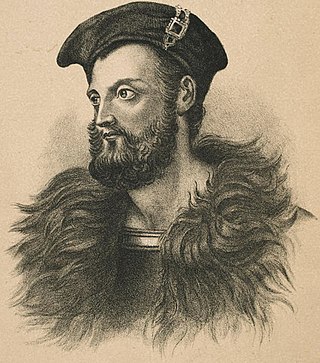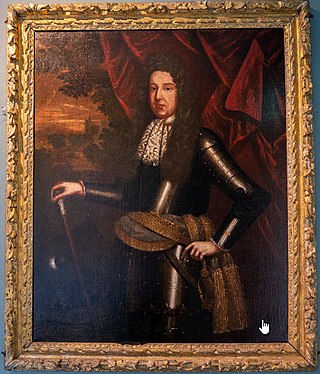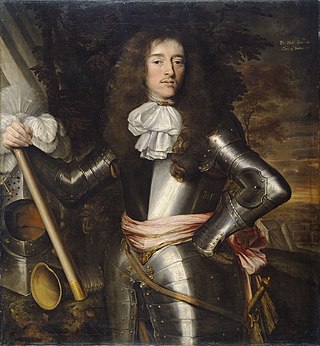This article needs additional citations for verification .(July 2020) |
| |||||
| Centuries: | |||||
|---|---|---|---|---|---|
| Decades: | |||||
| See also: | Other events of 1646 List of years in Ireland | ||||
Events from the year 1646 in Ireland.
This article needs additional citations for verification .(July 2020) |
| |||||
| Centuries: | |||||
|---|---|---|---|---|---|
| Decades: | |||||
| See also: | Other events of 1646 List of years in Ireland | ||||
Events from the year 1646 in Ireland.

Lieutenant-General James FitzThomas Butler, 1st Duke of Ormond, KG, PC, was an Anglo-Irish statesman and soldier, known as Earl of Ormond from 1634 to 1642 and Marquess of Ormond from 1642 to 1661. Following the failure of the senior line of the Butler family, he was the second representative of the Kilcash branch to inherit the earldom.

Owen Roe O'Neill was a Gaelic Irish soldier and one of the most famous of the O'Neill dynasty of Ulster. O'Neill left Ireland at a young age and spent most of his life as a mercenary in the Spanish Army serving against the Dutch in Flanders during the Eighty Years' War. After the Irish Rebellion of 1641, O'Neill returned and took command of the Irish Confederate Ulster Army. He is known for his victory at the Battle of Benburb in 1646.
This article contains information about the literary events and publications of 1646.
Thomas Preston, 1st Viscount Tara was an Irish soldier of the 17th century. After lengthy service as a mercenary in the Spanish Army, Preston returned to Ireland following the outbreak of the Rebellion of 1641. He was appointed to command the Leinster Army of the Irish Confederacy, enjoying some success as well as a number of heavy defeats such as the Battle of Dungans Hill in 1647 where his army was largely destroyed. Like other Confederate leaders, Preston was a Catholic Royalist. He remained in close contact with the Lord Lieutenant the Marquess of Ormonde, and was a strong supporter of an alliance between Confederates and Royalists against the English Republicans.

The Irish Confederate Wars, also called the Eleven Years' War, took place in Ireland between 1641 and 1653. It was the Irish theatre of the Wars of the Three Kingdoms, a series of civil wars in the kingdoms of Ireland, England and Scotland – all ruled by Charles I. The conflict had political, religious and ethnic aspects and was fought over governance, land ownership, religious freedom and religious discrimination. The main issues were whether Irish Catholics or British Protestants held most political power and owned most of the land, and whether Ireland would be a self-governing kingdom under Charles I or subordinate to the parliament in England. It was the most destructive conflict in Irish history and caused 200,000–600,000 deaths from fighting as well as war-related famine and disease.

Sir Phelim Roe O'Neill of Kinard was an Irish politician and soldier who started the Irish rebellion in Ulster on 23 October 1641. He joined the Irish Catholic Confederation in 1642 and fought in the Wars of the Three Kingdoms under his cousin, Owen Roe O'Neill, in the Confederate Ulster Army. After the Cromwellian conquest of Ireland O’Neill went into hiding but was captured, tried and executed in 1653.

Confederate Ireland, also referred to as the Irish Catholic Confederation, was a period of Irish Catholic self-government between 1642 and 1652, during the Eleven Years' War. Formed by Catholic aristocrats, landed gentry, clergy and military leaders after the Irish Rebellion of 1641, the Confederates controlled up to two-thirds of Ireland from their base in Kilkenny; hence it is sometimes called the "Confederation of Kilkenny".

Giovanni Battista Rinuccini (1592–1653) was an Italian Roman Catholic archbishop in the mid-seventeenth century. He was a noted legal scholar and became chamberlain to Pope Gregory XV. In 1625 Pope Urban VIII made him the Archbishop of Fermo in Italy. In 1645 Pope Innocent X sent him to Ireland as Papal Nuncio. He brought money and weapons to help the Confederate Irish in its conflict against the English Parliamentarians. Rinuccini became the dominant figure of the hard-line Clerical Faction of the Confederates refusing the alliance with the Irish Royalists.

The Battle of Rathmines was fought on 2 August 1649, near the modern Dublin suburb of Rathmines, during the Irish Confederate Wars, an associated conflict of 1638 to 1651 Wars of the Three Kingdoms. It has been described as the 'decisive battle of the Engagement in Ireland.'

Lieutenant-General Michael Jones, c. 1606 to 10 December 1649, was an Irish-born soldier of Welsh descent who fought for Parliament and the Commonwealth in the War of the Three Kingdoms, primarily in Ireland. Third son of Lewis Jones, Bishop of Killaloe, his brothers Henry and Ambrose were both bishops in the Protestant Church of Ireland.

Sir Donough MacCarty, 1st Earl of Clancarty (1594–1665), was an Irish soldier and politician. He succeeded his father as 2nd Viscount Muskerry in 1641. He rebelled against the government and joined the Irish Catholic Confederation, demanding religious freedom as a Catholic and defending the rights of the Gaelic nobility. Later, he supported the King against his Parliamentarian enemies during the Cromwellian conquest of Ireland.
Heber MacMahon was bishop of Clogher and general in Ulster. He was educated at the Irish college, Douay, and at Louvain, and ordained a Roman Catholic priest 1625. He became bishop of Clogher in 1643 and a leader among the confederate Catholics. As a general of the Ulster army, he fought Oliver Cromwell at the Battle of Scarrifholis in 1650. He was defeated, taken prisoner and executed the same year.
Events from the year 1645 in Ireland.
Presented below is a chronology of the major events of the Irish Confederate Wars from 1641 to 1653. This conflict is also known as the Eleven Years War. The conflict began with the Irish Rebellion of 1641 and ended with the Cromwellian conquest of Ireland (1649–53).

Murrough MacDermod O'Brien, 1st Earl of Inchiquin, was an Irish nobleman and soldier, who came from one of the most powerful families in Munster. Known as Murchadh na dTóiteán, he initially trained for war in the Spanish service. He accompanied the Earl of Strafford into Leinster on the outbreak of the Irish Rebellion of 1641 and was appointed governor of Munster in 1642. He had some small success, but was hampered by lack of funds and he was outwitted by the Irish leader, Viscount Muskerry, at Cappoquin and Lismore. His forces dispersed at the truce of 1643.

Sir Theophilus Jones, was an Irish soldier and government official of Welsh descent. One of five sons born to Lewis Jones, Bishop of Killaloe in the Church of Ireland, he formed part of a close-knit and powerful Protestant family.
This is a timeline of events leading up to, culminating in, and resulting from the Wars of the Three Kingdoms.
The Battle of Portlester took place on 7 August 1643 near the town of Ballivor, Leinster in Ireland as part of the Irish Confederate Wars. It was fought between Irish Confederates under Owen Roe O'Neill and a Protestant Royalist force from Dublin under Lord Moore. The battle consisted primarily of an exchange of artillery fire in which Moore was killed and his army driven off, giving the Confederates victory.
Charles Moore, 2nd Viscount Moore of Drogheda (1603-1643) was an Irish aristocrat noted for his leadership of Irish Royalist forces in northern Leinster during the early stages of the Irish Confederate Wars.
Richard O'Farrell was an Irish soldier of the seventeenth century most notable for his service in the Irish Confederate Wars from 1642 to 1651. He rose to the rank of Lieutenant General.